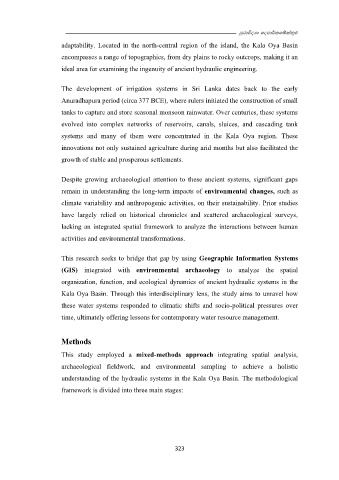Page 344 - Proceedings book
P. 344
mqrdúoHd fomd¾;fïka;=j
adaptability. Located in the north-central region of the island, the Kala Oya Basin
encompasses a range of topographies, from dry plains to rocky outcrops, making it an
ideal area for examining the ingenuity of ancient hydraulic engineering.
The development of irrigation systems in Sri Lanka dates back to the early
Anuradhapura period (circa 377 BCE), where rulers initiated the construction of small
tanks to capture and store seasonal monsoon rainwater. Over centuries, these systems
evolved into complex networks of reservoirs, canals, sluices, and cascading tank
systems and many of them were concentrated in the Kala Oya region. These
innovations not only sustained agriculture during arid months but also facilitated the
growth of stable and prosperous settlements.
Despite growing archaeological attention to these ancient systems, significant gaps
remain in understanding the long-term impacts of environmental changes, such as
climate variability and anthropogenic activities, on their sustainability. Prior studies
have largely relied on historical chronicles and scattered archaeological surveys,
lacking an integrated spatial framework to analyze the interactions between human
activities and environmental transformations.
This research seeks to bridge that gap by using Geographic Information Systems
(GIS) integrated with environmental archaeology to analyze the spatial
organization, function, and ecological dynamics of ancient hydraulic systems in the
Kala Oya Basin. Through this interdisciplinary lens, the study aims to unravel how
these water systems responded to climatic shifts and socio-political pressures over
time, ultimately offering lessons for contemporary water resource management.
Methods
This study employed a mixed-methods approach integrating spatial analysis,
archaeological fieldwork, and environmental sampling to achieve a holistic
understanding of the hydraulic systems in the Kala Oya Basin. The methodological
framework is divided into three main stages:
323

